Do Worms Have Antenna? Secrets of Earthworm Antennae
Worms – slippery, squirmy creatures that inhabit the dark, damp places of the world. While worms might seem simple at first glance, these invertebrates actually have some surprising abilities up their sleeve – or Segment? Flap? Okay worm anatomy is complicated, but you get the point!
One question that worms wiggle their way into is: Do worms have antenna? You may be picturing a little earthworm with tiny antennae waving around, exploring their underground lair. It’s a amusing thought, but worms don’t exactly have antennae in the insect sense of the word. Say what?!
I know, it’s a shocker given how antennae-like some worms appear. But while worms don’t have true antennae, they DO have some pretty crazy sensory abilities that help them navigate through the soil and water. Get ready to have your mind blown about just how skilled worms are at perceiving the world around them – sans antennae.
From bristly bundles to fluid-filled sacs, we’ll tunnel through the unexpected structures worms use instead of antennae. We’ll also dive underground to discover how these bizarre sensations allow worms to dig, feed, and even avoid danger in their environment.
No, worms do not have antenna-like sensory organs. Instead, they rely on a combination of chemoreceptors covering their body, light-sensitive cells in their prostomium, and setae for tactile sensation to navigate their underground environment and detect changes in their surroundings. While they lack antennae, earthworms have evolved a range of sensory adaptations to thrive in their habitat.
Do Earthworms Have Antenna?
To put it simply, no, earthworms do not have antenna-like insects. Antennae are prominent sensory appendages found in insects, which serve various functions such as detecting smells, vibrations, and changes in the environment. Earthworms, on the other hand, belong to a different group of animals known as annelids, and they lack antennae. Instead, they possess a different set of sensory organs that help them navigate through their subterranean habitat.

Earthworm Sensory Organs
While earthworms may not have antenna, they possess an array of sensory organs that aid in their survival and behavior. These sensory structures are distributed throughout their body and allow them to respond to different stimuli in their environment. Let’s take a closer look at the sensory organs found in earthworms:
- Tactile Receptors: Earthworms have numerous tactile receptors all over their body, which enable them to sense touch and vibrations. These receptors are especially important for detecting potential threats and finding their way through the soil.
- Chemosensory Organs: Earthworms have chemoreceptors that allow them to detect chemical cues in the soil. These receptors help them locate food sources and assess the quality of the soil they encounter.
- Photoreceptors: While earthworms are not capable of sight in the way humans are, they do possess light-sensitive cells called photoreceptors. These cells can detect changes in light levels and help earthworms determine whether they are in darkness or exposed to light.
- Hygroreceptors: Earthworms are highly sensitive to moisture levels in their environment. They have specialized hygroreceptors that allow them to sense changes in humidity, helping them avoid overly dry or waterlogged areas.
- Olfactory Sensilla: Earthworms can detect and respond to various odors in their surroundings. They have olfactory sensilla, which are tiny structures equipped with olfactory receptors that enable them to perceive smells.
How Do Earthworms Navigate Without Antennae?
Despite lacking antennae, earthworms are remarkably adept at navigating their underground environment. Their sensory organs, as mentioned earlier, play a crucial role in helping them find food, avoid predators, and locate suitable habitats for burrowing. Here’s how earthworms manage to navigate without antenna:
- Tactile Sensitivity: The abundance of tactile receptors on their skin allows earthworms to sense changes in texture and vibrations caused by nearby movements. This enables them to respond quickly to potential dangers and avoid harm.
- Chemical Detection: Earthworms rely heavily on their chemosensory organs to detect chemical cues in the soil, such as the presence of decaying organic matter or potential food sources. This skill helps them locate suitable spots for feeding and burrowing.
- Moisture and Light Detection: The hygroreceptors and photoreceptors in earthworms play essential roles in guiding their movements. They can sense variations in moisture levels and respond accordingly to avoid dry or waterlogged conditions. Additionally, they can detect light changes to determine if they are in the dark or exposed to light.
- Olfactory Capabilities: Earthworms’ ability to perceive smells through their olfactory sensilla helps them locate food sources and avoid substances that may be harmful to them.
Key Takeaway
Although earthworms lack antenna, they possess an array of sensory organs that are equally effective in helping them navigate their underground habitat. These sensory structures enable earthworms to detect touch, vibrations, chemicals, moisture levels, and changes in light, all of which are crucial for their survival.
The absence of antenna in earthworms is a testament to the diversity of sensory adaptations found in different animal groups. Understanding the sensory capabilities of these fascinating creatures allows us to appreciate the complexity and efficiency of nature’s designs.
What is a worm with antenna?
A worm with antenna is not a typical worm but an insect. Antenna are special sensory structures found on the heads of insects. They look like long, thin, and flexible feelers.
How many antennas does a worm have?
Most worms do not have antenna at all. Worms, like earthworms, are not insects, so they don’t have antenna. Instead, they have other sensory organs to help them navigate their environment.
